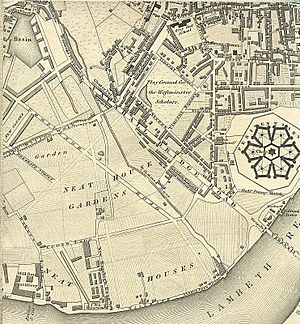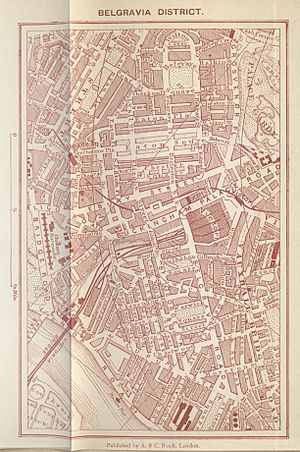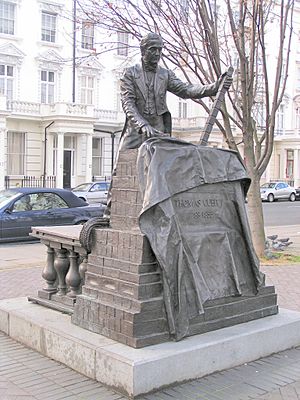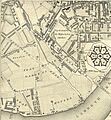Pimlico facts for kids
Quick facts for kids Pimlico |
|
|---|---|
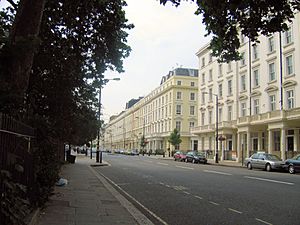 Belgrave Road from St George's Square |
|
 Map of Pimlico |
|
| OS grid reference | TQ295785 |
| London borough | |
| Ceremonial county | Greater London |
| Region | |
| Country | England |
| Sovereign state | United Kingdom |
| Post town | LONDON |
| Postcode district | SW1V |
| Dialling code | 020 |
| Police | Metropolitan |
| Fire | London |
| Ambulance | London |
| EU Parliament | London |
| UK Parliament |
|
| London Assembly | |
Pimlico is a cool area in Central London, part of the City of Westminster. It was built as an extension to its neighbor, Belgravia. Pimlico is famous for its pretty garden squares and unique Regency architecture.
The area is bordered by Victoria Station to the north and the River Thames to the south. To the east is Vauxhall Bridge Road, and to the west is the old Grosvenor Canal. At its heart, you'll find a grid of streets designed by Thomas Cubitt starting in 1825. This area is now protected as the Pimlico Conservation Area. The most impressive homes are around St George's Square, Warwick Square, and Eccleston Square. Newer additions include Dolphin Square (built before World War II) and the Churchill Gardens and Lillington and Longmoore Gardens housing estates. Pimlico has over 350 buildings listed as Grade II and several churches listed as Grade II*. Near the border with Chelsea, Pimlico Road is now known for its interior design shops.
Contents
History of Pimlico
How Pimlico Got Its Name
In the 1500s and 1600s, the land that is now Pimlico was part of the Manor of Ebury. The Crown (the King or Queen) leased out parts of this land. In 1623, King James I sold the land for about £1,151.
The land was sold many times until it came into the hands of a young heiress named Mary Davies in 1666. Mary's dowry (the money or property she brought into her marriage) included not only the "Five Fields" of Pimlico and Belgravia, but also much of what is now Mayfair and Knightsbridge.
In 1677, at just 12 years old, Mary married Sir Thomas Grosvenor, 3rd Baronet. The Grosvenor family, who were from Cheshire, became incredibly wealthy by developing and managing this land over time.
Sometime in the late 1600s or early 1700s, the area stopped being called Ebury or "The Five Fields." It became known as Pimlico. The exact origin of the name is debated. Some believe it came from a man named Ben Pimlico, who was famous for his special ale. His "tea-gardens" were near Hoxton, and the road to them was called Pimlico Path. So, the area might have been named after this popular spot.
Writer H. G. Wells suggested in his novel The Dream that Pimlico was a wharf where ships from America docked. He thought the name came from the Algonquin Indian language (Pamlico).
Pimlico's Growth and Changes
By the 1800s, London needed more homes, especially in the West End. This was after the Great Plague of London and the Great Fire of London. So, Pimlico was ready for new buildings. In 1825, Thomas Cubitt, a famous builder, was hired by Lord Grosvenor to develop Pimlico. The land used to be marshy, but it was filled in with soil from the building of St Katharine Docks.
Cubitt built Pimlico with many beautiful white stucco (a type of plaster) terraces. The biggest and fanciest houses were built along St George's Drive and Belgrave Road. Large squares like Eccleston, Warwick, and St George's Square also had grand homes. Lupus Street had similar grand houses, shops, and even a hospital for women and children. Smaller, three-story homes were built on the side streets.
In 1877, a newspaper said Pimlico was "respectable," a place for "professional men." These were people who weren't rich enough for Belgravia but could afford private houses. They were described as "more lively than in Kensington" and "a cut above Chelsea."
Even though many well-off people lived there, some parts of Pimlico started to decline by the 1890s. When Rev Gerald Olivier moved to the area in 1912 with his family, including young Laurence Olivier, it was seen as a venture into London's "slums."
In the late 1800s, several Peabody Estates were built in Pimlico. These were housing projects created by charities to provide good, affordable homes.
Pimlico in the 1900s
Pimlico's closeness to the Houses of Parliament made it a hub for political activity. Before 1928, the Labour Party and the Trades Union Congress shared offices in Eccleston Square. The general strike was even planned there in 1926.
In the mid-1930s, Pimlico saw another wave of building with Dolphin Square. This was a huge complex of 1,250 fancy flats built where Cubitt's workshops used to be. Finished in 1937, it quickly became popular with Members of Parliament (MPs) and government workers. It was also the headquarters for the Free French during much of World War II.
Pimlico kept its main character after the war, even though some parts were badly damaged by bombs. In the 1950s, these damaged areas were rebuilt. This led to the creation of the Churchill Gardens and Lillington and Longmoore Gardens estates. Many large Victorian houses were also turned into hotels.
To provide affordable heating for the new homes, Pimlico got a special district heating system. This system, called the Pimlico District Heating Undertaking (PDHU), started in 1950. It used to get waste heat from the old Battersea Power Station across the river. Today, it still works, but the water is heated locally by a new energy center.
In 1953, the Second Duke of Westminster sold the part of the Grosvenor estate where Pimlico is built.
Pimlico got its own London Underground station in 1972, as a late addition to the Victoria line. Since 1968, the area has been a conservation area, which means its special character is protected. This has led to a lot of improvements. Pimlico now has a mix of fancy restaurants and homes, along with facilities run by Westminster City Council.
For a history of street name meanings in the area see: Street names of Pimlico and Victoria
Famous Buildings in Pimlico
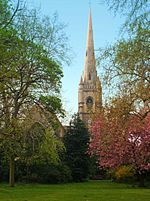
Dolphin Square is a large block of private apartments built between 1935 and 1937. When it was built, it was the biggest self-contained block of flats in Europe. Many Members of Parliament (MPs) live there.
Churchill Gardens is a big housing estate in the southwest of Pimlico. It was built between 1946 and 1962 by architects Powell and Moya. It replaced old docks, factories, and some of Cubitt's terraces that were damaged in the Blitz during the war.
On Buckingham Palace Road, you can see the old "Empire Terminal" of Imperial Airways. This cool Art Moderne building was designed in 1938 by Albert Lakeman. Mail, cargo, and passengers traveled from here by train to Southampton to board flying boats. Today, the building is the main office for the National Audit Office.
Pimlico has several Anglican churches, built when the neighborhood was first laid out. These include St Gabriel's, St Saviour, and St James the Less. The area's Catholic church, Holy Apostles, was destroyed in the Blitz and rebuilt in 1957. The main office for Catholic Bishops in England and Wales is in Eccleston Square.
Tate Britain is very close to Pimlico Underground station and is considered a landmark. This art museum and the Chelsea College of Art and Design (which moved to the former Royal Army Medical College next to the Tate) connect the area to fine art.
Pimlico School, a large school built between 1967 and 1970, was a famous example of Brutalist architecture (a style using raw concrete). It was torn down in 2010.
Famous People from Pimlico
Blue Plaques in Pimlico
You can find special blue plaques on buildings where famous people lived:
- Aubrey Beardsley, an illustrator, lived at 114 Cambridge Street.
- Sir Winston Churchill, a famous politician, lived at 33 Eccleston Square and Morpeth Terrace.
- Joseph Conrad, a Polish-born British novelist, lived at 17 Gillingham Street.
- Jomo Kenyatta, the first president of Kenya, lived at 95 Cambridge Street.
- Swami Vivekananda, a Hindu philosopher, lived briefly at 63 St George's Drive.
- Major Walter Clopton Wingfield, known as the father of lawn tennis, lived at 33 St George's Square.
Other Notable Residents
Many other well-known people have lived in Pimlico:
- Charles De Gaulle, the leader of the Free French during WWII and later French president, lived in Dolphin Square.
- Isadora Duncan, a famous American dancer, lived at 33 Warwick Square.
- Steve Hackett, former guitarist for the band Genesis.
- William Hague, a former British Foreign Secretary.
- Jeremy Hunt, a politician.
- Rhys Ifans, a Welsh actor.
- Catherine Johnson, who created the musical Mamma Mia!.
- Oswald Mosley, a British political leader, lived in Dolphin Square.
- Bill Nighy, an actor.
- Laurence Olivier, a very famous actor, lived at 22 Lupus Street.
- Barbara Pym, a writer, lived at 108 Cambridge Street.
- Bram Stoker, the author of Dracula, died at 26 St George's Square.
- Gianluca Vialli, an Italian football player and manager.
- Paul Weller, a singer/songwriter, lived in Pimlico in the early 1980s.
- The 1960s band Small Faces lived at 22 Westmoreland Terrace.
Pimlico in Books and Movies
Pimlico has been featured in many stories:
- The 1940 movie Gaslight is set in Pimlico.
- After World War II, the 1949 comedy movie Passport To Pimlico was also set here.
- In G. K. Chesterton's book Orthodoxy, Pimlico is used as an example of something that can become great if loved.
- Writer Barbara Pym used St Gabriel's Church as her inspiration for a church in her novel Excellent Women.
- The main character in Michael Dobbs's 1989 novel House of Cards lives in Pimlico.
- The online novel Corduroy Mansions by Alexander McCall Smith is set in Pimlico.
- The main character in the 2015 novel Watchmaker of Filigree Street lives in Pimlico.
- Some scenes from Season 4 of the Netflix series You' were filmed in Pimlico.
Learning in Pimlico
Pimlico has schools for different age groups. For more details on schools in the area, you can check the list of schools in the City of Westminster.
Getting Around Pimlico
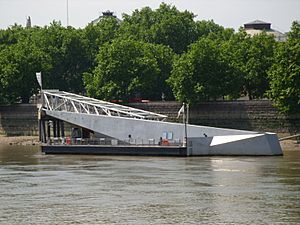
Pimlico is easy to reach by public transport:
- The Pimlico station is on the Victoria line.
- Victoria station is nearby, serving the Victoria, District, and Circle lines.
- You can also catch National Rail trains from London Victoria Station.
- Local bus routes like the 24, 360, and C10 run through Pimlico. Many more buses run along Vauxhall Bridge Road.
- Riverboat services to Waterloo and Southwark leave from Millbank Millennium Pier.
- Pimlico also has many docking stations for the Santander Cycles bike-sharing scheme.
There are plans for a new pedestrian bridge across the River Thames from St George's Square to the Nine Elms and Battersea Power Station area.
How Pimlico is Governed
Pimlico is part of the Westminster City Council. It is divided into two areas for local elections: Pimlico North and Pimlico South. These areas are part of the Cities of London and Westminster parliamentary area, which is currently represented by MP Nickie Aiken from the Conservative party.
Pimlico is also part of the West Central area for the London Assembly, represented by James Small-Edwards AM.
Pimlico's Neighbors
 |
Belgravia | Victoria | Westminster and St James's |  |
| Chelsea | Millbank | |||
| Battersea | Nine Elms | Vauxhall |
Images for kids
-
Greenwood's 1827 map showing parts of Pimlico and Millbank prior to development
-
St Gabriel's Church in Warwick Square
-
Riverboat services run from Millbank Millennium Pier
See also
 In Spanish: Pimlico para niños
In Spanish: Pimlico para niños



